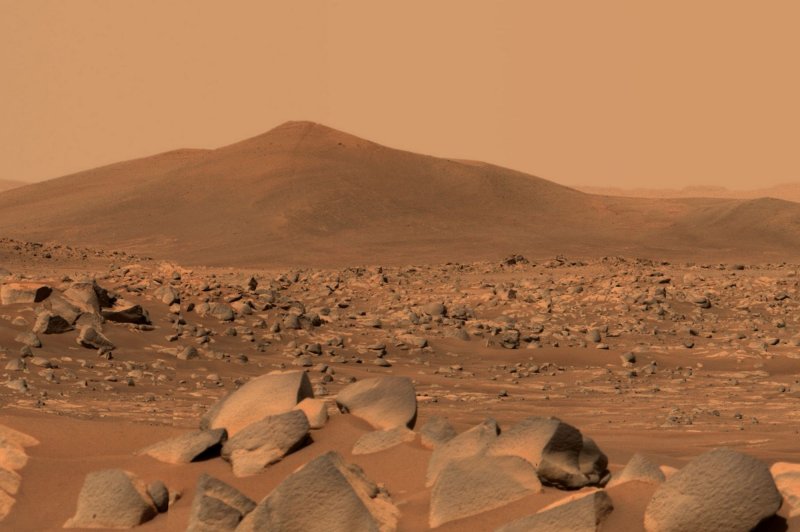
A team of researchers proposed using plasma reactors to extract oxygen from Mars' atmosphere in a study published Thursday.
File Photo by NASA/UPI | License Photo
Aug. 16 (UPI) -- A group of scientists have developed a plasma-based method of producing and separating oxygen on Mars, according to a study published Thursday.
The team of researchers from the University of Lisbon, the Massachusetts Institute of Technology, Sorbonne University, Eindhoven University of Technology and the Dutch Institute for Fundamental Energy Research shared a method that can harness and process local resources on Mars to produce oxygen and other products, according to the study in the Journal of Applied Physics.
The Martian atmosphere is primarily made up of carbon dioxide that can be split to produce oxygen using electron beams.
"By converting different molecules directly from the Martian atmosphere, plasmas can create the necessary feed-stock and base chemicals for processing fuels, breathing oxygen, building materials and fertilizers," the study's abstract states.
Scientists said the method could serve as a complementary approach to NASA's Mars Oxygen In-Situ Resource Utilization Experiment, or MOXIE, presenting the potential to deliver high rates of molecule production while sending less instrumentation to space.
Vasco Guerra, a University of Lisbon physicist who authored the study, said that creating and accelerating a beam of electrons is much easier on Mars, where the air is about 100 times thinner than Earth's.
"There is an ideal pressure for plasma operation," he said. "Mars has precisely this correct pressure."
Aug. 16 (UPI) -- A group of scientists have developed a plasma-based method of producing and separating oxygen on Mars, according to a study published Thursday.
The team of researchers from the University of Lisbon, the Massachusetts Institute of Technology, Sorbonne University, Eindhoven University of Technology and the Dutch Institute for Fundamental Energy Research shared a method that can harness and process local resources on Mars to produce oxygen and other products, according to the study in the Journal of Applied Physics.
The Martian atmosphere is primarily made up of carbon dioxide that can be split to produce oxygen using electron beams.
"By converting different molecules directly from the Martian atmosphere, plasmas can create the necessary feed-stock and base chemicals for processing fuels, breathing oxygen, building materials and fertilizers," the study's abstract states.
Scientists said the method could serve as a complementary approach to NASA's Mars Oxygen In-Situ Resource Utilization Experiment, or MOXIE, presenting the potential to deliver high rates of molecule production while sending less instrumentation to space.
Vasco Guerra, a University of Lisbon physicist who authored the study, said that creating and accelerating a beam of electrons is much easier on Mars, where the air is about 100 times thinner than Earth's.
"There is an ideal pressure for plasma operation," he said. "Mars has precisely this correct pressure."
He added that there are two major hurdles to producing oxygen on Mars that the method seeks to reduce.
"First, the decomposition of carbon dioxide molecules to extract oxygen. It's a very difficult molecule to break," said Guerra. "Second, the separation of the produced oxygen from a gas mixture that also contains, for example, carbon dioxide and carbon monoxide. We're looking at these two steps in a holistic way to solve both challenges at the same time. This is where plasmas can help."
Michael Hecht, an experimental scientist at the Massachusetts Institute of Technology, also noted that the plasma device would need a portable power source and a place to store the oxygen it provides but said the approach could develop to avoid the bulk with the right investment.
"There's nothing wrong with the plasma technique other than it's a lot less mature [than MOXIE]," he said.
No comments:
Post a Comment